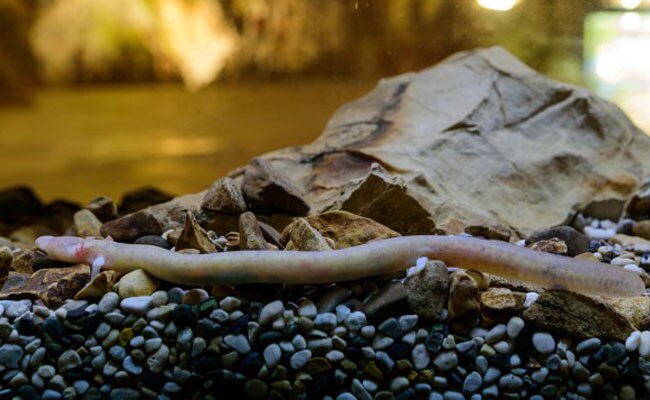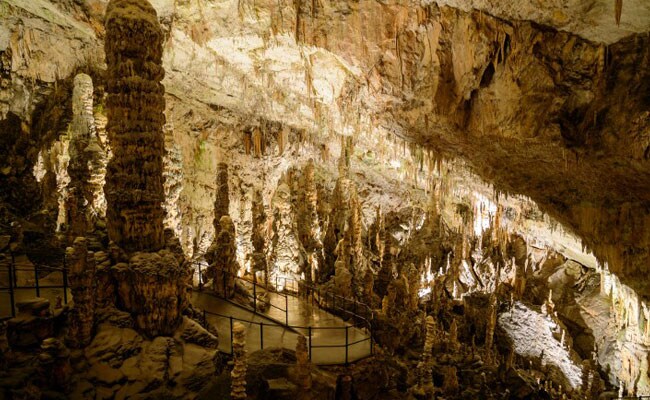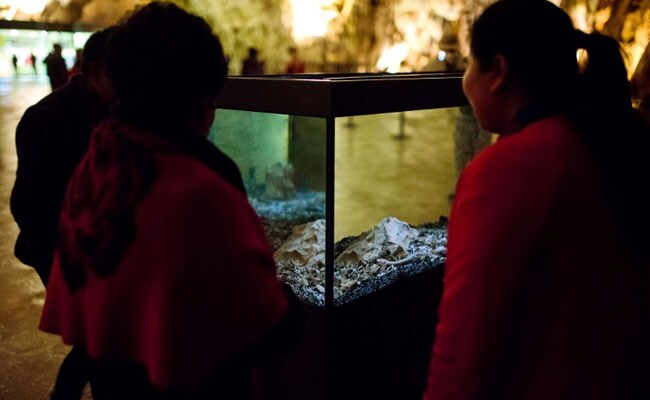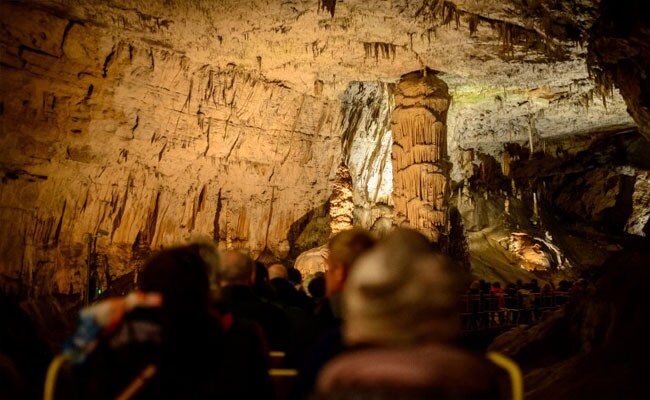
An olm is an ancient underwater predator, which can live up to 100 years and only breed once in a decade. (AFP Photo)
- Olms are ancient, blind salamanders that are said to resemble dragons
- They can live up to 100 years and can survive without food for 10 years
- For the first time, public may be able to view a hatching of 57 eggs
Did our AI summary help?
Let us know.
Postojna, Slovenia:
The strange, slithery creatures inside Slovenia's Postojna cave were once considered living proof that dragons existed, prompting locals to give it a wide berth.
Now large crowds from all over the world queue up to witness the extremely rare hatching of the mysterious olms -- ancient underwater predators, which can live up to 100 years and only breed once in a decade.
Found primarily in Balkan cave rivers, the protected eel-like species has been living in the world-famous Postojna cave, 50 kilometres (30 miles) southwest of the capital Ljubljana, for what researchers say is millions of years.
In early June, the tourist attraction is set to become one of the first ever human-controlled environments to breed two dozen of the cave salamanders.
 "It's one of those moments where you are happy to be alive now and experience such a unique event," said Saso Weldt, a biologist working at Postojna, one of Europe's largest caves that draws 700,000 visitors a year.
"It's one of those moments where you are happy to be alive now and experience such a unique event," said Saso Weldt, a biologist working at Postojna, one of Europe's largest caves that draws 700,000 visitors a year.
"These are the only olm eggs at the moment people can actually see. Nobody has ever found them in the wild."
Inside a large hall, the mother and her precious spawn are kept in complete darkness in a covered tank under the continuous watch of a night-vision camera.
On a nearby television screen, visitors can see the tiny translucent eggs spread over a rock. From time to time, one of the embryos stirs ever so lightly.
"Fingers crossed we'll soon be able to announce the good news," Postojna cave spokeswoman Sabina Paternost told AFP in late May.
No food for 10 years
The biologists hope the new arrivals will help to shed fresh light on the enigmatic creature, which has become a national symbol and even featured on Slovenia's currency before the euro was introduced.
 While locals now fondly talk of their "baby dragons", people for centuries were too afraid to even go near the cave.
While locals now fondly talk of their "baby dragons", people for centuries were too afraid to even go near the cave.
During winter, heavy rains would wash out the wriggly larvae from the grotto as it lay surrounded by a sea of thick fog, according to 17th century folk tales.
Slovenians believed them to be the offspring of fire-breathing "dragons living inside the dangerous cave", explained Weldt.
Reaching a maximum length of 35 centimetres (13.5 inches), the blind animal with its four tiny limbs is a far cry from the scary monsters conjured up in national folklore.

Sometimes also referred to as "human fish", the slim vertebrate sports three feathery gills on each side of its elongated snout. The body's translucent pink skin makes it easy to spot the internal organs and determine the sex.
Its cave-dwelling existence has equipped the olm with some extremely powerful skills.
In place of sight, it has developed acute sensory receptors for smell and movement, helping it to hunt for prey like crabs and snails in the dark, or snap at intruders.
Even more impressively, the small predator can go without food for up to a decade.
'Flagship species'
Breeding olms is a delicate and often fatal affair. A previous try in 2013 failed to produce any fertilised eggs at Postojna.
But the latest attempt looks more promising.
Of the 60 or so eggs laid in January this year, 24 are still alive, with their gills functional and their hearts clearly beating.
For those who make it, the path to adulthood will be long: "They will take around 10 to 15 years to reach their full size," noted Weldt.
And even then, their long-term survival is not guaranteed.
 Although not officially endangered, the species is nevertheless considered vulnerable as it finds itself at risk of environmental changes like pollution seeping into the so-called karsts, or caves created from water eating through soluble rocks like limestone.
Although not officially endangered, the species is nevertheless considered vulnerable as it finds itself at risk of environmental changes like pollution seeping into the so-called karsts, or caves created from water eating through soluble rocks like limestone.
"Olms are a flagship species need of protection. If there's too much pollution, they will disappear," warned Weldt.
Now large crowds from all over the world queue up to witness the extremely rare hatching of the mysterious olms -- ancient underwater predators, which can live up to 100 years and only breed once in a decade.
Found primarily in Balkan cave rivers, the protected eel-like species has been living in the world-famous Postojna cave, 50 kilometres (30 miles) southwest of the capital Ljubljana, for what researchers say is millions of years.
In early June, the tourist attraction is set to become one of the first ever human-controlled environments to breed two dozen of the cave salamanders.

Found primarily in Balkan cave rivers, the protected eel-like species has been living in the world-famous Postojna cave. (AFP Photo)
"These are the only olm eggs at the moment people can actually see. Nobody has ever found them in the wild."
Inside a large hall, the mother and her precious spawn are kept in complete darkness in a covered tank under the continuous watch of a night-vision camera.
On a nearby television screen, visitors can see the tiny translucent eggs spread over a rock. From time to time, one of the embryos stirs ever so lightly.
"Fingers crossed we'll soon be able to announce the good news," Postojna cave spokeswoman Sabina Paternost told AFP in late May.
No food for 10 years
The biologists hope the new arrivals will help to shed fresh light on the enigmatic creature, which has become a national symbol and even featured on Slovenia's currency before the euro was introduced.

The world-famous Postojna cave, 50 kilometres (30 miles) southwest of the capital Ljubljana. (AFP Photo)
During winter, heavy rains would wash out the wriggly larvae from the grotto as it lay surrounded by a sea of thick fog, according to 17th century folk tales.
Slovenians believed them to be the offspring of fire-breathing "dragons living inside the dangerous cave", explained Weldt.
Reaching a maximum length of 35 centimetres (13.5 inches), the blind animal with its four tiny limbs is a far cry from the scary monsters conjured up in national folklore.

Tourists observe an olm, an ancient underwater predator. (AFP Photo)
Sometimes also referred to as "human fish", the slim vertebrate sports three feathery gills on each side of its elongated snout. The body's translucent pink skin makes it easy to spot the internal organs and determine the sex.
Its cave-dwelling existence has equipped the olm with some extremely powerful skills.
In place of sight, it has developed acute sensory receptors for smell and movement, helping it to hunt for prey like crabs and snails in the dark, or snap at intruders.
Even more impressively, the small predator can go without food for up to a decade.
'Flagship species'
Breeding olms is a delicate and often fatal affair. A previous try in 2013 failed to produce any fertilised eggs at Postojna.
But the latest attempt looks more promising.
Of the 60 or so eggs laid in January this year, 24 are still alive, with their gills functional and their hearts clearly beating.
For those who make it, the path to adulthood will be long: "They will take around 10 to 15 years to reach their full size," noted Weldt.
And even then, their long-term survival is not guaranteed.

Tourists ride on a train in Postojna Cave on April 25, 2016 as they came to see olms. (AFP Photo)
"Olms are a flagship species need of protection. If there's too much pollution, they will disappear," warned Weldt.
Track Latest News Live on NDTV.com and get news updates from India and around the world

